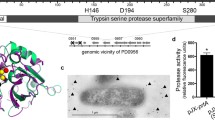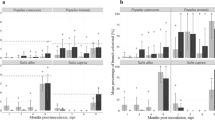Abstract
Xylella fastidiosa causes Pierce’s disease (PD), a serious disease in grapevines, and grapevine cultivars vary in susceptibility to X. fastidiosa in the field. The mechanism(s) by which this occurs has not been clearly elucidated. To explore possible mechanisms, X. fastidiosa cells from a PD strain were grown in pure xylem fluid of PD-susceptible grapevines, Vitis vinifera and V. labrusca, versus PD-resistant grapevines, V. champinii and V. smalliana. When grown in xylem fluid from the susceptible species, X. fastidiosa cells formed a heavier biofilm compared to those in xylem fluid from the resistant species. Differential expression of selected genes of X. fastidiosa cultured in the xylem fluids of V. vinifera and V. smalliana was analyzed using a DNA macroarray. Compared with xylem fluid of V. smalliana, xylem fluid of V. vinifera stimulated the expression of X. fastidiosa genes involved in virulence regulation, such as rpfC, gacA, xrvA, gcvR, and cysB, and genes involved in biogenesis of pili and twitching motility, such as pilI, pilU, pilE and pilG. Increased expression of virulence genes likely contributes to the expression of PD symptom in the susceptible grapevines, whereas reduced expression of these genes may lead to limitation of symptoms in resistant grapevines.



Similar content being viewed by others
Abbreviations
- PD:
-
Pierce’s disease
- RT-PCR:
-
Reverse transcription polymerase chain reaction
References
Alves, E., Marucci, C. R., Lopes, J. R. S., & Leite, B. (2004). Leaf symptoms on plum, coffee and citrus and the relationship with the extent of xylem vessels colonized by Xylella fastidiosa. Journal of Phytopathology, 152, 291–297.
Andersen, P. C. (2002) Biological, cultural, genetic, and chemical control of Pierce’s Disease: xylem fluid chemistry mediation of resistance to Pierce’s Disease. p. 43–44. In: Proceedings of the Pierce’s Disease Research Symposium. California Department of Food and Agriculture, San Diego, CA.
Andersen, P. C., Brodbeck, B. V., Oden, S., Shriner, A., & Leite, B. (2007). Influence of xylem fluid chemistry on planktonic growth, biofilm formation and aggregation of Xylella fastidiosa. FEMS Microbiology Letters, 274, 210–217.
Basha, S. M., Mazhar, H., & Vasanthaiah, H. K. N. (2010). Proteomics approach to identify unique xylem fluid proteins in Pierce’s disease-tolerant Vitis Species. Applied Biochemistry and Biotechnology, 160, 932–944.
Bi, J. L., Dumenyo, C. K., Hernandez-Martinez, R., Cooksey, D. A., & Toscano, N. C. (2007). Effect of host plant xylem fluid on growth, aggregation, and attachment of Xylella fastidiosa. Journal of Chemical Ecology, 33, 493–500.
Biles, C. L., & Abeles, F. B. (1991). Xylem sap proteins. Plant Physiology, 96, 597–601.
Chatterjee, S., Wistrom, C., & Lindow, S. E. (2008). A cell-cell signaling sensor is required for virulence and insect transmission of Xylella fastidiosa. Proceedings of the National Academy of Sciences of the United States of America, 105, 2670–2675.
Clayton, C. N. (1975). Diseases of muscadine and bunch grapes in North Carolina and their control. North Carolina Agricultural Experiment Station Technical Bulletin, 451, 37.
Costa, H. S., Raetz, E., Pinlard, T. R., Gispert, C., Hernandez-Martinez, R., Dumenyo, C. K., & Cooksey, D. A. (2004). Plant hosts of Xylella fastidiosa in and near southern California vineyards. Plant Disease, 88, 1255–1261.
de Souza, A. A., Takita, M. A., Pereira, E. O., Coletta-Filho, H. D., & Machado, M. A. (2005). Expression of pathogenicity-related genes of Xylella fastidiosa in vitro and in planta. Current Microbiology, 50, 223–228.
Fritschi, F. B., Lin, H., & Walker, M. A. (2007). Xylella fastidiosa population dynamics in grapevine genotypes differing in susceptibility to Pierce’s disease. American Journal of Enology and Viticulture, 3, 326–332.
Fry, S. M., & Milholland, R. D. (1990). Response of resistant, resistance and susceptible grapevine tissue to invasion by the Pierce’s disease bacterium, Xylella fastidiosa. Phytopathology, 80, 66–69.
Gray, D. (2003). New plants for Florida: Grape. Circular 1440. In R. L. Jones, M. L. Duryea, & B. J. Treat (Eds.), Florida agricultural experiment station. Gainesville: Institute of Food and Agricultural Sciences, University of Florida.
Gusnanto, A., Ploner, A., & Pawitan, Y. (2005). Fold-change estimation of differentially expressed genes using mixture mixed-model. Statistical Applications in Genetics and Molecular Biology, 4, 1145–1149.
Hopkins, D. L. (1984). Variability of virulence in grapevine among isolates of Pierce’s disease bacterium. Phytopathology, 74, 1395–1398.
Hopkins, D. L., & Purcell, A. H. (2002). Xylella fastidiosa: cause of Pierce’s disease of grapevine and other emerging diseases. Plant Disease, 86, 1056–1066.
Leite, B., Andersen, P. C., & Ishida, M. L. (2004). Colony aggregation and biofilm formation in xylem chemistry-based media for Xylella fastidiosa. FEMS Microbiology Letters, 230, 283–290.
Lopez-Millan, A. F., Morales, F., Abadia, A., & Abadia, J. (2000). Effects of iron deficiency on the composition of the leaf apoplastic fluid and xylem sap in sugar beet. Implications for iron and carbon transport. Plant Physiololgy, 124, 873–884.
Lu, J., Ren, Z. B., & Cousins, P. (2008). Evaluation of grape rootstocks for resistance to Pierce’s disease and adaptation to north Florida environment. Acta Horticulture, 772, 257–262.
Marques, L. L. R., Manfio, G. P., Reid, D. M., Ceri, H., & Olson, M. E. (2001). Xylella fastidiosa are biofilm-forming phytopathogenic bacteria. Phytopathology, 91, S58.
Meng, Y., Li, Y., Galvani, C. D., Hao, G., Turner, J. N., Burr, T. J., & Hoch, H. C. (2005). Upstream migration of Xylella fastidiosa via pilusdriven twitching motility. Journal of Bacteriology, 187, 5560–5567.
Osiro, D., Colnago, L. A., Otoboni, A. M., Lemos, E. G., de Souza, A. A., Coletta Filho, H. D., & Machado, M. A. (2004). A kinetic model for Xylella fastidiosa adhesion, biofilm formation, and virulence. FEMS Microbiology Letters, 236, 313–318.
Redak, R. A., Purcell, A. H., Lopes, J. R. S., Blua, M. J., Mizell, R. F., III, & Andersen, P. C. (2004). The biology of xylem fluid-feeding insect vectors of Xylella fastidiosa and their relation to disease epidemiology. Annual Review of Entomology, 49, 243–270.
Shi, X. Y., Dumenyo, C. K., Hernandez-Martinez, R., Azad, H., & Cooksey, D. A. (2007). Characterization of regulatory pathways in Xylella fastidiosa: genes and phenotypes controlled by algU. Applied and Environmental Microbiology, 73, 6748–6756.
Shi, X. Y., Dumenyo, C. K., Hernandez-Martinez, R., Azad, H., & Cooksey, D. A. (2009). Characterization of regulatory pathways in Xylella fastidiosa: genes and phenotypes controlled by gacA. Applied and Environmental Microbiology, 75, 2275–2283.
Shi, X. Y., Bi, J. L., Morse, J. G., Toscano, N. C., & Cooksey, D. C. (2010). Differential expression of genes of Xylella fastidiosa in xylem fluid of citrus and grapevine. FEMS Microbiology Letters, 304, 82–88.
Simpson, A. J., Reinach, F. C., Arruda, P., Abreu, F. A., Acencio, M., Alvarenga, R., Alves, L. M., Araya, J. E., Baia, G. S., Baptista, C. S., Barros, M. H., et al. (2000). The genome sequence of the plant pathogen Xylella fastidiosa. Nature, 406, 151–157.
St. Geme, J. W., III, & Cutter, D. (1995). Evidence that surface fibrils expressed by Haemophilus influenzae type b promote attachment to human epithelial cells. Molecular Microbiology, 15, 77–85.
Sun, Q., Greve, C. L., & Labavitch, J. M. (2011). Polysaccharide Compositions of Intervessel Pit Membranes Contribute to Pierce’s Disease Resistance of Grapevines. Plant Physiololgy, 155, 1976–1987.
Takiya, D. M., McKamey, S. H., & Cavichioli, R. R. (2006). Validity of Homalodisca and of H. vitripennis as the name for glassy-winged sharpshooter (Hemiptera: Cicadellidae Cicadellinae). Annals of the Entomological Society of America, 99, 648–655.
Van Sluys, M. A., de Oliveira, M. C., Monteiro-Vitorello, C. B., Miyaki, C. Y., Furlan, L. R., Camargo, L. E., da Silva, A. C., Moon, D. H., Takita, M. A., Lemos, E. G., Machado, M. A., et al. (2003). Comparative analyses of the complete genome sequences of Pierce’s disease and citrus variegated chlorosis strains of Xylella fastidiosa. Journal of Bacteriology, 185, 1018–1026.
Wells, J. M., Raju, B. C., Huang, H. Y., Weiburh, W. G., Mandelcopaul, L., & Brennder, D. J. (1987). Xylella fastidiosa gen. nov.: Gram negative, xylem limited fastidious plant bacteria related to Xanthomonas spp. International Journal of Systematic Bacteriology, 36, 136–143.
Zaini, P. A., De La Fuente, H. L., Hoch, C., & Burr, T. J. (2009). Grapevine xylem sap enhances biofilm development by Xylella fastidiosa. FEMS Microbiology Letters, 259, 129–134.
Acknowledgments
We thank Jiue-in Yang for collecting the xylem fluids. This work was supported in part by the University of California’s Pierce’s Disease Research Grants Program via a grant from USDA CSREES, the California Department of Food and Agriculture Pierce’s Disease/Glassy-winged Sharpshooter Board, and the University of California Agricultural Experiment Station.
Author information
Authors and Affiliations
Corresponding author
Rights and permissions
About this article
Cite this article
Shi, X., Bi, J., Morse, J.G. et al. Effect of xylem fluid from susceptible and resistant grapevines on developmental biology of Xylella fastidiosa . Eur J Plant Pathol 135, 127–135 (2013). https://doi.org/10.1007/s10658-012-0071-9
Accepted:
Published:
Issue Date:
DOI: https://doi.org/10.1007/s10658-012-0071-9




